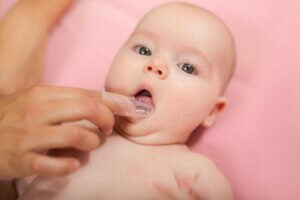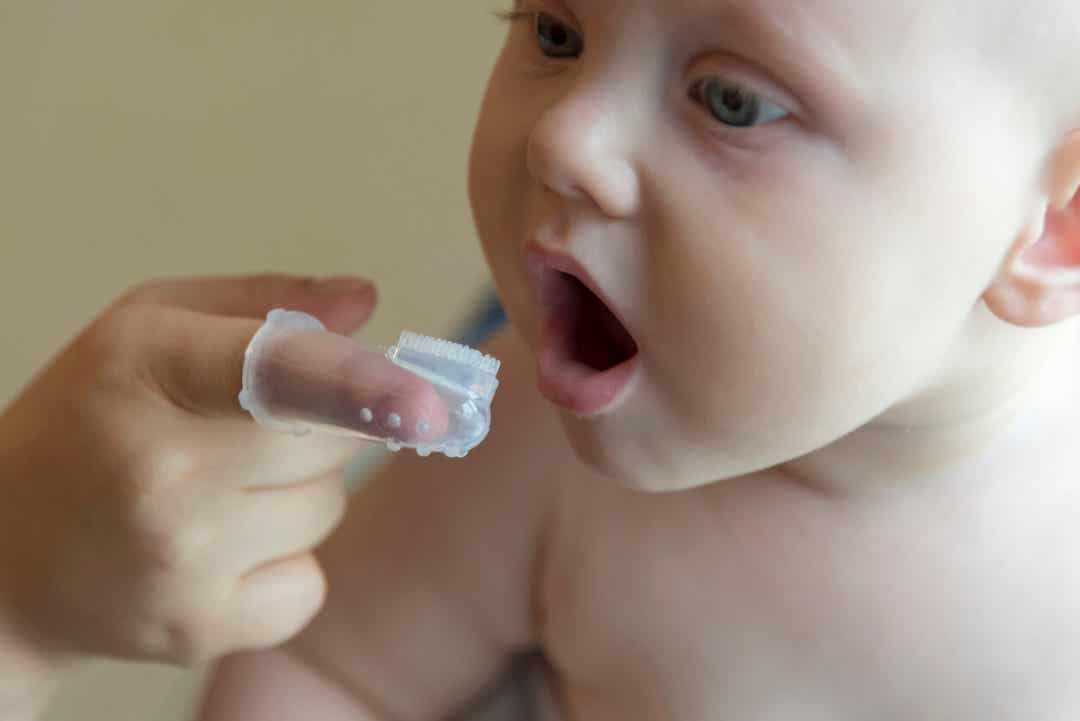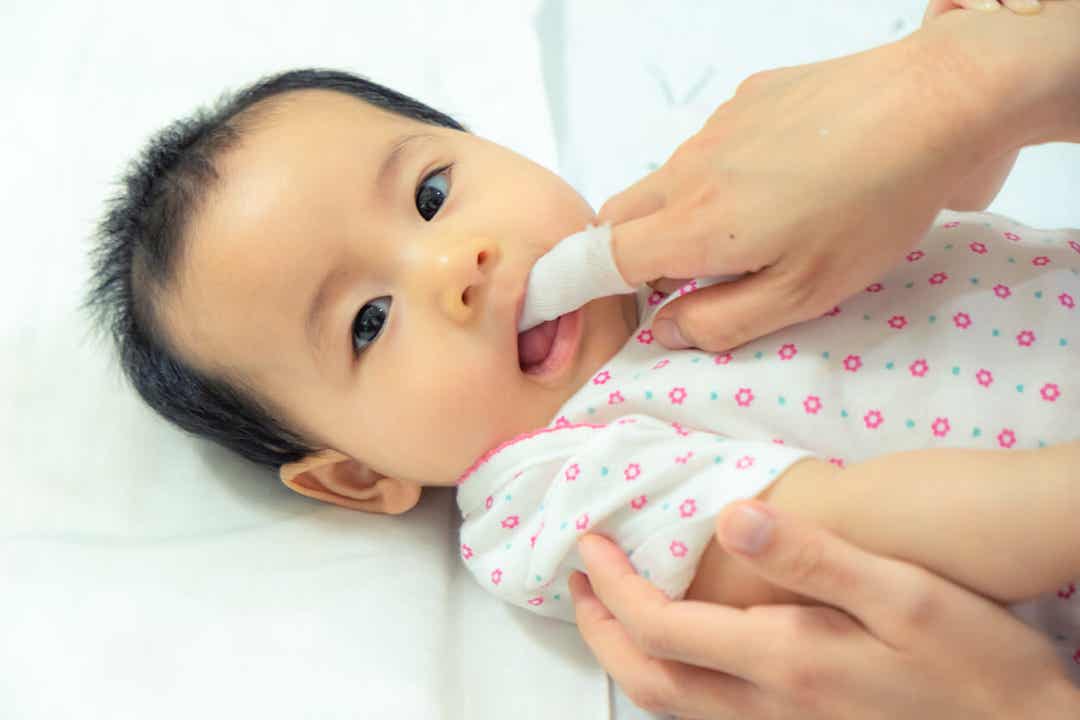Should You Clean Your Baby's Gums?

Paying attention to mouth care from an early age can make all the difference in a person’s oral health. That’s why it’s so important to clean your baby’s gums from birth.
With this simple practice, your little one’s incorporating the cleaning of the oral cavity as part of the routine care of their body. When their teeth grow in, brushing won’t be new or unfamiliar, and keeping teeth healthy will be easier.
In addition, cleaning babies’ gums reduces the risk of tooth decay and relieves the discomfort of teething. Here, we’ll tell you everything you should know about this habit that’s so helpful when it comes to our children’s health.
Your baby’s gums
Babies’ mouths are a very important structure for their development. In the first months of life, children discover the world through the oral cavity and the sensations they experience through it. This is why they’re so prone to put everything they find in their mouths.

A baby’s gums play a very important role in exploration and during feeding. When they nurse, the gums interact with the tongue, which, through its movements, make it possible to extract the mother’s milk in order to swallow it.
Inside the newborn’s mouth, the baby’s gingival gingivae or gums can be observed. This is pale pink mucous tissue that covers the bone on which the teeth will grow. Some areas may even be bumpy due to the presence of dental germs from the future teeth underneath.
Some children may have small yellowish-white formations on their gums. These are Bohn’s nodules, a harmless alteration in which remains of embryonic glandular tissue persist and disappear on their own with time.
The teeth will eventually appear on these structures. For all these reasons, care and attention to this part of the body are essential as soon as possible.
Cleaning the gums of babies from birth
It’s very important to clean your baby’s gums as early on as possible. Here are some of the benefits of incorporating this practice into your child’s care routine early:
- Disease prevention: Removing milk debris and bacteria that remain accumulated on the tongue and gums decreases the risk of tooth decay in the milk teeth when they come in.
- Building the habit: Getting children used to taking care of their mouths from the beginning avoids difficulties or resistance that may appear when introducing brushing later on. The child becomes accustomed to cleaning the oral cavity as part of their daily routine and enjoys the pleasant sensation of having a clean mouth.
- Massaging the gums: During gum cleaning, a pleasant massage is produced in the mouth. This sensation can alleviate the discomfort that irritates little ones when their baby teeth come in.
How to clean your baby’s gums without causing distress
It can be overwhelming for parents to have to clean such a small mouth. With patience, willpower, and a little practice, it’s possible and not so complicated. Here’s how to do it the right way.
The only supplies needed are warm water and some gauze or clean washcloths. First, the adult who’s going to perform the task should wash their hands thoroughly with soap and water.
Then, they should lay the baby on their lap, holding the head with one of their hands. With the other hand, roll the clean gauze around the index finger and wet it with the warm water.
Carefully open the baby’s mouth and rub the cloth over the gums in gentle circular motions. The tongue and inside of the cheeks should also be cleaned.
Some parents find it easier to do this task by using special thimble-shaped brushes. You simply insert your finger into the thimble. Because they have soft silicone bristles, the gums can be massaged and cleaned.
When the first tooth appears in the mouth, it’s time to make the transition to using a toothbrush. It should be small and soft to clean the teeth that appear in the mouth. The rest of the oral structures can be cleaned gently with the brush, silicone thimbles, or gauze.
Also, when the teeth appear, toothpaste can be used in minimal amounts (the size of a grain of rice). Always follow the instructions of your child’s pediatric dentist.
Some tricks to cleaning your baby’s gums

Cleaning babies’ gums can be an unpleasant moment for some children. Adults shouldn’t get upset or irritated. Accompanying them with affection, motivating them, and helping them to enjoy the routine is very important in order for them to gradually incorporate this habit.
Here are some tips that can be useful for making the cleaning of your baby’s gums more pleasant:
- Songs: Singing a soothing song to calm the child or a special song about cleaning the mouth can make the moment more fun.
- Set an example: Having an adult brush their own teeth at the same time as the child is a good way to show the little one the importance of oral hygiene.
- Take advantage of bath time: Cleaning the mouth during or after a relaxing bath can be a good idea. The child will be better predisposed and it’ll be part of the body care routine.
- Take turns brushing: With older children, you can take turns brushing their mouths. First, the child’s given a brush so that they can practice cleaning and then the adult finishes the cleaning.
Parents who take care of their children’s mouths
Now you know that you don’t have to wait for your little one’s teeth to come in before you start taking care of them. Cleaning your baby’s gums prevents mouth complications, so it’s very important to start as soon as possible.
Taking care of children’s oral health is vital when it comes to guaranteeing a healthy smile in the future. With responsibility, patience, and lots of love, every parent can do it.
Paying attention to mouth care from an early age can make all the difference in a person’s oral health. That’s why it’s so important to clean your baby’s gums from birth.
With this simple practice, your little one’s incorporating the cleaning of the oral cavity as part of the routine care of their body. When their teeth grow in, brushing won’t be new or unfamiliar, and keeping teeth healthy will be easier.
In addition, cleaning babies’ gums reduces the risk of tooth decay and relieves the discomfort of teething. Here, we’ll tell you everything you should know about this habit that’s so helpful when it comes to our children’s health.
Your baby’s gums
Babies’ mouths are a very important structure for their development. In the first months of life, children discover the world through the oral cavity and the sensations they experience through it. This is why they’re so prone to put everything they find in their mouths.

A baby’s gums play a very important role in exploration and during feeding. When they nurse, the gums interact with the tongue, which, through its movements, make it possible to extract the mother’s milk in order to swallow it.
Inside the newborn’s mouth, the baby’s gingival gingivae or gums can be observed. This is pale pink mucous tissue that covers the bone on which the teeth will grow. Some areas may even be bumpy due to the presence of dental germs from the future teeth underneath.
Some children may have small yellowish-white formations on their gums. These are Bohn’s nodules, a harmless alteration in which remains of embryonic glandular tissue persist and disappear on their own with time.
The teeth will eventually appear on these structures. For all these reasons, care and attention to this part of the body are essential as soon as possible.
Cleaning the gums of babies from birth
It’s very important to clean your baby’s gums as early on as possible. Here are some of the benefits of incorporating this practice into your child’s care routine early:
- Disease prevention: Removing milk debris and bacteria that remain accumulated on the tongue and gums decreases the risk of tooth decay in the milk teeth when they come in.
- Building the habit: Getting children used to taking care of their mouths from the beginning avoids difficulties or resistance that may appear when introducing brushing later on. The child becomes accustomed to cleaning the oral cavity as part of their daily routine and enjoys the pleasant sensation of having a clean mouth.
- Massaging the gums: During gum cleaning, a pleasant massage is produced in the mouth. This sensation can alleviate the discomfort that irritates little ones when their baby teeth come in.
How to clean your baby’s gums without causing distress
It can be overwhelming for parents to have to clean such a small mouth. With patience, willpower, and a little practice, it’s possible and not so complicated. Here’s how to do it the right way.
The only supplies needed are warm water and some gauze or clean washcloths. First, the adult who’s going to perform the task should wash their hands thoroughly with soap and water.
Then, they should lay the baby on their lap, holding the head with one of their hands. With the other hand, roll the clean gauze around the index finger and wet it with the warm water.
Carefully open the baby’s mouth and rub the cloth over the gums in gentle circular motions. The tongue and inside of the cheeks should also be cleaned.
Some parents find it easier to do this task by using special thimble-shaped brushes. You simply insert your finger into the thimble. Because they have soft silicone bristles, the gums can be massaged and cleaned.
When the first tooth appears in the mouth, it’s time to make the transition to using a toothbrush. It should be small and soft to clean the teeth that appear in the mouth. The rest of the oral structures can be cleaned gently with the brush, silicone thimbles, or gauze.
Also, when the teeth appear, toothpaste can be used in minimal amounts (the size of a grain of rice). Always follow the instructions of your child’s pediatric dentist.
Some tricks to cleaning your baby’s gums

Cleaning babies’ gums can be an unpleasant moment for some children. Adults shouldn’t get upset or irritated. Accompanying them with affection, motivating them, and helping them to enjoy the routine is very important in order for them to gradually incorporate this habit.
Here are some tips that can be useful for making the cleaning of your baby’s gums more pleasant:
- Songs: Singing a soothing song to calm the child or a special song about cleaning the mouth can make the moment more fun.
- Set an example: Having an adult brush their own teeth at the same time as the child is a good way to show the little one the importance of oral hygiene.
- Take advantage of bath time: Cleaning the mouth during or after a relaxing bath can be a good idea. The child will be better predisposed and it’ll be part of the body care routine.
- Take turns brushing: With older children, you can take turns brushing their mouths. First, the child’s given a brush so that they can practice cleaning and then the adult finishes the cleaning.
Parents who take care of their children’s mouths
Now you know that you don’t have to wait for your little one’s teeth to come in before you start taking care of them. Cleaning your baby’s gums prevents mouth complications, so it’s very important to start as soon as possible.
Taking care of children’s oral health is vital when it comes to guaranteeing a healthy smile in the future. With responsibility, patience, and lots of love, every parent can do it.
All cited sources were thoroughly reviewed by our team to ensure their quality, reliability, currency, and validity. The bibliography of this article was considered reliable and of academic or scientific accuracy.
- Saavedra Alvarado, Violeta Thalía. Alteraciones bucales del recién nacido. BS thesis. Universidad de Guayaquil. Facultad Piloto de Odontología, 2020. http://repositorio.ug.edu.ec/handle/redug/49802
- Castillo Laysa, Giovana Lisbet. “Efecto de programa educativo “cuidando a mi bebe” en el nivel de conocimientos de madres adolescentes sobre cuidados del recién nacido Hospital la Caleta 2016.” (2018). http://repositorio.uns.edu.pe/handle/UNS/3141
- Nolasco Mejia, Bryan Alessandro. “Nivel de conocimiento sobre salud bucal en gestantes que acuden al servicio de gineco-obstetricia del hospital La Caleta distrito de Chimbote-provincia del Santa-Ancash, marzo 2013.” http://repositorio.uladech.edu.pe/handle/123456789/20100
- Portaro, Camila Palma, and Ailin Cabrera Matta. “importancia de los primeros años de vida.” PREMIO MEDALLA DE ORO: 5. http://www.fihu.org.pe/wp-content/uploads/2018/05/revista-diagnostico-web.pdf#page=7
- Pinto, José M., Daniela B. Chávez, and Catalina Navarrete. “Salud bucal en el primer año de vida. Revisión de la literatura y protocolo de atención odontológica al bebé.” (2018). http://bdigital2.ula.ve:8080/xmlui/handle/654321/3819
- AL HABLA, C. O. N., et al. “SALUD BUCAL INFANTIL: PORQUE CADA EDAD NECESITA UN CUIDADO ESPECÍFICO.” https://www.dentaid.com/uploads_filiales/resources/doc_01%20Expertise%2026_b__v1.pdf
- Centeno, José Eduardo Orellana. “Cuidados de la salud bucodental en él bebe.” https://www.researchgate.net/profile/Jose-Orellana-7/publication/343150681_Cuidados_de_la_salud_bucodental_en_el_bebe/links/5f18ffd5a6fdcc9626aa2b4a/Cuidados-de-la-salud-bucodental-en-el-bebe.pdf
This text is provided for informational purposes only and does not replace consultation with a professional. If in doubt, consult your specialist.








